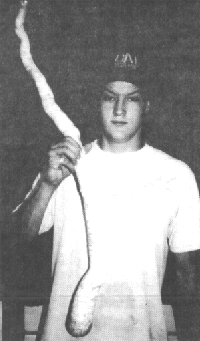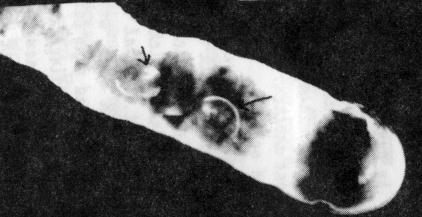|
Xray Conchology |
|
|
By Harry G. Lee |
|
|
Over the years, several
shell enthusiasts have applied Xray techniques to allow a better
understanding of the structure of molluscan shells, but the
following account may be one of the few in which shells were
captured on film from a characteristic niche, but were invisible
to the naked eye. At least a few of us are familiar with the "stove-pipe shell," a long irregular to nearly rectilinear shelly tube which may reach six feet in length. Over the course of my shelling experience, various luminaries have written accounts of this natural history object with widely variant degrees of veracity. Some popular articles attribute their tube to a giant gastropod "worm-snail" (example Vermicularia or Vermetidae), others to a worm (?Annelida). In fact, the author of the scientific name, Serpula polythalamia Linnaeus, 1767 placed it in a genus with an Annelid worm, and in 1758 thought it was conspecific with a Vermetid (wormsnail). |
|
|
|
|
|
Author's son (185.4 cm.) with specimen described herein. |
|
|
For many years a solitary,
intact, alcohol-preserved specimen of this creature, collected in
the Solomon Islands, reposed in London's British Museum (Natural
History). Almost 30 years ago Dr. Ruth Turner broke it apart and
extracted the animal. In 1966 she reported her findings in an
extensive monograph on shipworms - the benchmark work on the
group. The anatomic features allowed her to hypothesize that Kuphus
was the most primitive of the shipworms. She learned that the
habitat was the mud of mangrove swamps in the torrid S. W.
Pacific. Because of the lack of ridges on the anterior margin of
the valves, she deduced that the animal was incapable of
burrowing in wood. Based of these perspectives, she hypothesized
that the ancestral shipworm was probably a mud-dwelling burrower
more akin the Kuphus
and any other surviving stock. Dr. Turner didn't describe the tube of Kuphus exhaustively. Let me tell you what I have observed. Until recently very few intact specimens were available to collectors. This year two Sanibel shell dealers Larry Strange and Al Deynzer, have gotten "good" specimens of this natural history object from the Philippines. An intact specimen in my collection measures 40 inches in length. It slowly tapers from the 4 1/2 inch diameter closed rounded anterior end to a septate open posterior end which is subovate and about 1 1/2 inches across (See illustration). It is through this pair of openings that the animal extends its inhalant and excurrent siphons - each of which shares the aperture with a specialized set of "pallets" (like all other shipworms) used to close the openings in the tube when the siphons have withdrawn - as with an environmental threat. One of the fun things related to "shell" study is getting new perspectives on the critters. The accompanying photos (See below) shows a view of my Kuphus tube (much reduced) By shaking and twisting the specimen, I was able to position the shells (trapped inside after the shipworm' s demise) in various poses. I'll let Dr. Turner reconstruct the 3D appearance of these shells, which measure slightly over 1 inch in maximum length. |
|
|
|
Xray of anterior end of Kuphus
|
| Reference: Turner, R. D. (1966) A Survey & Illustrated catalog Teredinidae (Mollusca: Bivalvia) Museum of Comp. Zoology, Cambridge. | |

